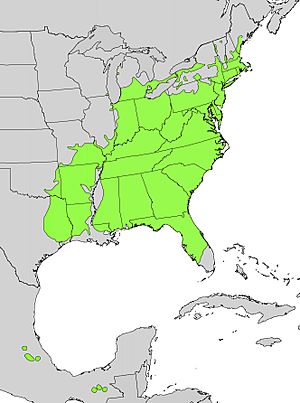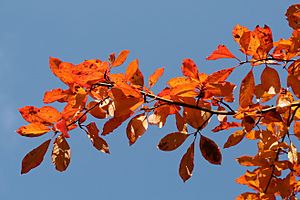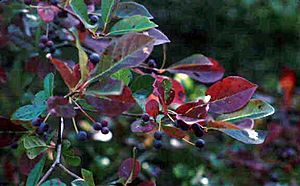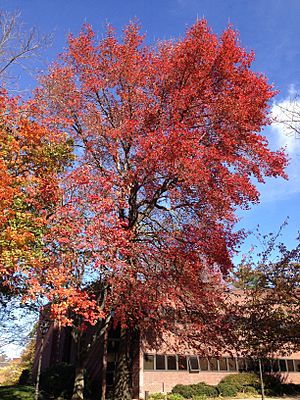Black tupelo facts for kids
Nyssa sylvatica, often called tupelo, black tupelo, black gum, or sour gum, is a medium-sized tree that loses its leaves in autumn. It grows naturally in eastern North America, from the northeastern United States and southern Ontario, all the way south to central Florida and eastern Texas. You can also find it in Mexico.
Quick facts for kids Black tupelo |
|
|---|---|
 |
|
| Foliage and almost mature fruit | |
| Conservation status | |
| Scientific classification | |
| Genus: |
Nyssa
|
| Species: |
sylvatica
|
 |
|
| Natural range | |
Contents
Tree Names: What Do They Mean?
The scientific name for this tree is Nyssa sylvatica. The first part, Nyssa, comes from an ancient Greek word for a water nymph. This makes sense because the tree often grows near water. The second part, sylvatica, means "of the woods," referring to its natural home in forests.
The common name, tupelo, comes from Native American words. It's from the Creek language, where ito means "tree" and opilwa means "swamp." This name was used as early as the mid-1700s.
People often just say "tupelo." But "black tupelo" helps tell it apart from other trees in the same Nyssa family. Some of these, like water tupelo, grow in similar areas.
In the southern United States, it's mostly called tupelo. But further north, especially in the Appalachian Mountains, it's known as black gum or sour gum. Even though it's called "gum," the tree doesn't actually produce a sticky gum. These names help tell it apart from the "sweet gum" tree, which does make a sticky, sweet-smelling sap. Another name you might hear in the northeastern United States is pepperidge.
There's also a type of black tupelo called Nyssa sylvatica var. caroliniana, sometimes called Yellow Gum. This one grows on dry land and hills, not in swamps.
On Martha's Vineyard in Massachusetts, people call this tree "beetlebung." This name might come from its wood being used to make mallets. These mallets were used to hammer "bungs" (stoppers) into barrels.
Tree Features: What Does It Look Like?
The black tupelo tree usually grows to be about 20 to 25 meters (65 to 80 feet) tall. Sometimes, it can reach 35 meters (115 feet). Its trunk can be 50 to 100 centimeters (20 to 40 inches) wide. The tree often has a straight trunk with branches that stick out straight from the sides.
When the tree is young, its bark is dark gray and flaky. As it gets older, the bark becomes deeply grooved, looking a bit like alligator skin. The small branches are reddish-brown.
The leaves of the black tupelo can be different shapes and sizes. They are usually oval or egg-shaped, about 5 to 12 centimeters (2 to 5 inches) long. The top of the leaves is shiny. In autumn, the leaves turn a beautiful purple, then a bright, fiery red. Deer love to eat the leaves of young black tupelo trees. This can make it hard for new trees to grow in areas with many deer.
The flowers are very tiny and greenish-white. They grow in clusters on long stalks. These flowers are a great source of nectar for bees. Some trees have only male or only female flowers, so you need both nearby to get fruit. But many trees have both male and female flowers on the same tree.
The fruit is a small, oval-shaped berry, about 10 millimeters (0.4 inches) long. It's dark blue or black. The fruit has a thin, oily flesh that tastes bitter or sour. Small birds, especially the American robin, really like these fruits. They are an important food source for birds.
Young black tupelo trees grow a long, deep main root called a taproot. This makes them hard to move once they start growing. Because of this, you don't see them planted in gardens as often as some other trees.
Where Does the Black Tupelo Grow?
The black tupelo grows in many different places. You can find it from southwestern Maine and New York, west to southern Ontario, Michigan, Illinois, and Missouri. It also grows south to Florida, eastern Texas, and Oklahoma. You can even find it in parts of central and southern Mexico. It grows best in the southeastern United States, especially on lower slopes and flat areas near rivers.
Black Tupelo and Nature
The black tupelo lives in many different environments, from dry uplands to wet swampy areas. Its flowers provide important nectar for honeybees. Its fruits are a vital food source for many birds and mammals. The hollow trunks of older trees can become homes for bees and other animals like squirrels and raccoons. This tree is one of the longest-living flowering plants in eastern North America. It can live for over 650 years!
Where It Lives
Because it grows over such a large area, the black tupelo can be found in many different climates. It grows in creek bottoms in the southern coastal plains. It also grows high up in the Appalachian Mountains, sometimes as high as 900 meters (3,000 feet). These trees grow best in soil that drains well, like on low ridges or flat areas near rivers. In higher, drier areas, it grows best on lower slopes and in sheltered spots.
Wildlife and the Black Tupelo
The black tupelo is a very important food source for many birds that migrate in the fall. Its leaves turn color early in autumn. This bright color might help attract birds to its ripe fruits. These fruits ripen before many other berries in the fall. The dark blue fruits grow in clusters of two or three. Many birds love these sour fruits, including:
- American robin
- Swainson's thrush
- Gray-cheeked thrush
- Hermit thrush
- Wood thrush
- Northern cardinal
- Northern mockingbird
- Blue jay
- Red-bellied woodpecker
- Yellow-bellied sapsucker
- Northern flicker
- Pileated woodpecker
- Eastern phoebe
- Brown thrasher
- Eastern bluebird
- European starling
- Scarlet tanager
- Gray catbird
- Cedar waxwing
- American crow
These birds either live in the tree's range all year or pass through during migration.
The branches of black tupelo trees often get hollow as they age. These hollow spots make great dens for squirrels, raccoons, and opossums. They are also good nesting spots for honeybees.
How People Use Black Tupelo
Growing It in Gardens
The black tupelo is grown as an ornamental tree in parks and large gardens. It's often used as a special tree or to provide shade. It grows best in places that are protected but not too crowded. When young, it has a pyramid shape, and as it gets older, it spreads out. Its branches grow straight out from the trunk or droop a little.
Its amazing autumn colors, from bright reds to purples, are highly valued in landscaping. Many people think it has the most brilliant fall color among trees like maple, dogwood, sassafras, and sweet gum.
In the UK, a special type of black tupelo called 'Wisley Bonfire' has won an award for being a great garden plant.
Honey Production
The black tupelo is a major source of wild honey in many areas where it grows. In the past, beekeepers sometimes used hollow sections of black gum trunks as "bee gums" to keep their bees in.
Wood Uses
The wood of the black tupelo is heavy, hard, and tough. It's very difficult to split, especially after it dries. Because it resists splitting, it was used to make mallets (large hammers), pulleys, and parts for wheels. It was also used for bowls and paving blocks for roads. Today, its wood is used for pallets, rough floors, and firewood.
Since the wood is very tough and resists wear, it has been used for shuttles in weaving machines. It also takes in wood preservatives well, making it a top choice for railroad ties. Its resistance to wear and some acids means it's also used for factory flooring.
Teeth-Cleaning Twig
Native Americans traditionally used twigs from the black tupelo to clean their teeth. They also used them for dipping snuff.
|
See also
 In Spanish: Nyssa sylvatica para niños
In Spanish: Nyssa sylvatica para niños






